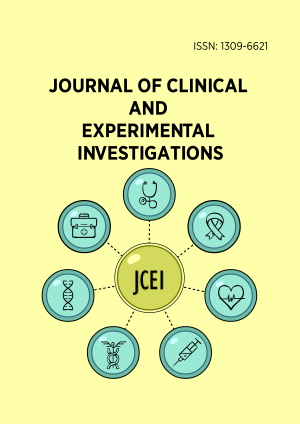Volume 4, Issue 4, December 2013
Research Article
Risk factors for recurrence and morbidity in reoperative thyroid surgery: a different point of view
J Clin Exp Invest, Volume 4, Issue 4, December 2013, 417-421
https://doi.org/10.5799/ahinjs.01.2013.04.0317Research Article
Expression of voltage-gated sodium channel in primary tumors and corresponding metastases in the Copenhagen rat model of prostate cancer
J Clin Exp Invest, Volume 4, Issue 4, December 2013, 422-428
https://doi.org/10.5799/ahinjs.01.2013.04.0318Research Article
Long-term changes in sexual functions following complicated pregnancies and deliveries
J Clin Exp Invest, Volume 4, Issue 4, December 2013, 429-435
https://doi.org/10.5799/ahinjs.01.2013.04.0319Research Article
Incidence of pterygium in patients admitted to a university hospital
J Clin Exp Invest, Volume 4, Issue 4, December 2013, 436-442
https://doi.org/10.5799/ahinjs.01.2013.04.0320Research Article
Orthopedic approach to foreign body injuries
J Clin Exp Invest, Volume 4, Issue 4, December 2013, 443-448
https://doi.org/10.5799/ahinjs.01.2013.04.0321Research Article
Seropositivity of HBsAg, anti-HCV and anti-HIV in preoperative patients
J Clin Exp Invest, Volume 4, Issue 4, December 2013, 449-452
https://doi.org/10.5799/ahinjs.01.2013.04.0322Research Article
The prognostic impact of the detection of metastatic inferior mediastinal lymph node in non-small cell lung cancer at preoperative term
J Clin Exp Invest, Volume 4, Issue 4, December 2013, 453-456
https://doi.org/10.5799/ahinjs.01.2013.04.0323Research Article
Effects of postoperative early motion on the results of osteosynthesis with miniplates in metacarpal fractures
J Clin Exp Invest, Volume 4, Issue 4, December 2013, 457-462
https://doi.org/10.5799/ahinjs.01.2013.04.0324Research Article
Carotid intima-media thickness and neutrophils/lymphocytes ratio in patients with overt and subclinical hypothyroidism
J Clin Exp Invest, Volume 4, Issue 4, December 2013, 463-467
https://doi.org/10.5799/ahinjs.01.2013.04.0325Research Article
Isolated secondary fungal infections of pleural cavity
J Clin Exp Invest, Volume 4, Issue 4, December 2013, 468-471
https://doi.org/10.5799/ahinjs.01.2013.04.0326Research Article
Effects of spermiogram parameters in patients who attempt intrauterine insemination
J Clin Exp Invest, Volume 4, Issue 4, December 2013, 472-476
https://doi.org/10.5799/ahinjs.01.2013.04.0327Research Article
Bonesetter choice of Turkish society in musculoskeletal injuries and the affecting factors
J Clin Exp Invest, Volume 4, Issue 4, December 2013, 477-482
https://doi.org/10.5799/ahinjs.01.2013.04.0328Research Article
Assessment of mean platelet volume in chronic obstructive pulmonary disease during stable period and acute exacerbation
J Clin Exp Invest, Volume 4, Issue 4, December 2013, 483-487
https://doi.org/10.5799/ahinjs.01.2013.04.0329Research Article
Prevalence and risk factors of vitamin D deficiency in patients with widespread musculoskeletal pain
J Clin Exp Invest, Volume 4, Issue 4, December 2013, 488-491
https://doi.org/10.5799/ahinjs.01.2013.04.0330Research Article
Investigation of the relationship between mean platelet volume and obstructive sleep apnea syndrome
J Clin Exp Invest, Volume 4, Issue 4, December 2013, 492-496
https://doi.org/10.5799/ahinjs.01.2013.04.0331Research Article
Thrombophilia in complicated pregnancies
J Clin Exp Invest, Volume 4, Issue 4, December 2013, 497-502
https://doi.org/10.5799/ahinjs.01.2013.04.0332Case Report
Successful management of a patient with toxic epidermal necrolysis by high dose intravenous immunoglobulin
J Clin Exp Invest, Volume 4, Issue 4, December 2013, 503-505
https://doi.org/10.5799/ahinjs.01.2013.04.0333Case Report
Solitary rectal diverticulum: A case report
J Clin Exp Invest, Volume 4, Issue 4, December 2013, 506-508
https://doi.org/10.5799/ahinjs.01.2013.04.0334Case Report
Trigeminal nerve involvement in congenital insensitivity of pain with anhidrosis
J Clin Exp Invest, Volume 4, Issue 4, December 2013, 509-511
https://doi.org/10.5799/ahinjs.01.2013.04.0335Case Report
Giant cell tumor of the distal tibia: Report of a rare case
J Clin Exp Invest, Volume 4, Issue 4, December 2013, 512-516
https://doi.org/10.5799/ahinjs.01.2013.04.0336Case Report
Acute kidney injury due to rhabdomyolysis after status epilepticus: Two pediatric case reports
J Clin Exp Invest, Volume 4, Issue 4, December 2013, 517-520
https://doi.org/10.5799/ahinjs.01.2013.04.0337Case Report
Primary cutaneous follicle center lymphoma in a 77-year-old woman
J Clin Exp Invest, Volume 4, Issue 4, December 2013, 521-524
https://doi.org/10.5799/ahinjs.01.2013.04.0338Case Report
A case of isolated inferior ST segment elevation myocardial infarction due to occlusion of the left anterior descending coronary artery and review of the literature
J Clin Exp Invest, Volume 4, Issue 4, December 2013, 525-528
https://doi.org/10.5799/ahinjs.01.2013.04.0339Case Report
A case of linear lichen planus: Using the accurate nomenclature
J Clin Exp Invest, Volume 4, Issue 4, December 2013, 529-531
https://doi.org/10.5799/ahinjs.01.2013.04.0340Case Report
Radiologic findings of olfactory neuroblastoma (Esthesioblastoma)
J Clin Exp Invest, Volume 4, Issue 4, December 2013, 532-534
https://doi.org/10.5799/ahinjs.01.2013.04.0341Case Report
The asymptomatic giant renal mass diagnosed due to its metastasis: Case report
J Clin Exp Invest, Volume 4, Issue 4, December 2013, 535-537
https://doi.org/10.5799/ahinjs.01.2013.04.0342Case Report
Central serous chorioretinopathy case with ooze sign
J Clin Exp Invest, Volume 4, Issue 4, December 2013, 538-541
https://doi.org/10.5799/ahinjs.01.2013.04.0343Case Report
A life-threatening abdominal abscess secondary to forgotten placental tissue during cesarean section: A case report
J Clin Exp Invest, Volume 4, Issue 4, December 2013, 542-545
https://doi.org/10.5799/ahinjs.01.2013.04.0344Case Report
Lumbar intraspinal synovial cyst with urine incontinence: A case report and review of the literature
J Clin Exp Invest, Volume 4, Issue 4, December 2013, 546-549
https://doi.org/10.5799/ahinjs.01.2013.04.0345Review
Induced pluripotent stem cells and cell therapy
J Clin Exp Invest, Volume 4, Issue 4, December 2013, 550-561
https://doi.org/10.5799/ahinjs.01.2013.04.0346Review
Diabetes mellitus and primary healthcare
J Clin Exp Invest, Volume 4, Issue 4, December 2013, 562-567
https://doi.org/10.5799/ahinjs.01.2013.04.0347Letter to Editor
A rare cause of non-atherosclerotic myocardial infarction: Rheumatoid arthritis
J Clin Exp Invest, Volume 4, Issue 4, December 2013, 568-569
https://doi.org/10.5799/ahinjs.01.2013.04.0348
